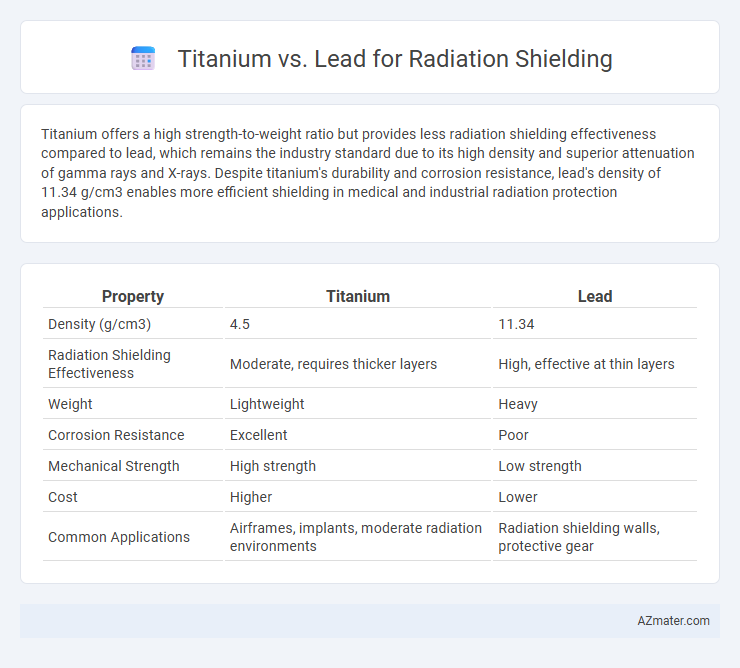Titanium offers a high strength-to-weight ratio but provides less radiation shielding effectiveness compared to lead, which remains the industry standard due to its high density and superior attenuation of gamma rays and X-rays. Despite titanium's durability and corrosion resistance, lead's density of 11.34 g/cm3 enables more efficient shielding in medical and industrial radiation protection applications.
Table of Comparison
| Property | Titanium | Lead |
|---|---|---|
| Density (g/cm3) | 4.5 | 11.34 |
| Radiation Shielding Effectiveness | Moderate, requires thicker layers | High, effective at thin layers |
| Weight | Lightweight | Heavy |
| Corrosion Resistance | Excellent | Poor |
| Mechanical Strength | High strength | Low strength |
| Cost | Higher | Lower |
| Common Applications | Airframes, implants, moderate radiation environments | Radiation shielding walls, protective gear |
Introduction to Radiation Shielding Materials
Radiation shielding materials primarily function to attenuate or block ionizing radiation, with effectiveness determined by density, atomic number, and thickness. Titanium offers a unique combination of moderate density (4.5 g/cm3) and high strength-to-weight ratio, making it ideal for lightweight shielding in aerospace and medical applications where weight reduction is crucial. Lead, with a high density of 11.34 g/cm3 and atomic number 82, provides superior attenuation of gamma rays and x-rays but poses challenges due to its toxicity and heavy weight.
Understanding Radiation Types and Shielding Needs
Different radiation types such as alpha, beta, gamma, and neutron radiation demand specific shielding materials, with lead excelling in attenuating gamma rays and X-rays due to its high density and atomic number. Titanium, while lighter and more corrosion-resistant, provides less effective gamma radiation shielding but offers advantages in neutron radiation environments due to its lower atomic number and reduced secondary radiation production. Effective radiation shielding design requires matching material properties like density, atomic number, and neutron absorption cross-section to the specific radiation type to optimize protection and structural performance.
Physical Properties: Titanium vs Lead
Titanium has a density of approximately 4.5 g/cm3, significantly lower than lead's density of 11.34 g/cm3, resulting in lighter radiation shielding materials. Despite its lower density, titanium offers higher tensile strength and corrosion resistance, making it suitable for environments requiring durability alongside radiation protection. Lead remains the preferred choice for shielding due to its superior atomic number (82) and density, which provide greater attenuation of gamma rays and X-rays compared to titanium.
Radiation Attenuation Efficiency
Titanium exhibits lower radiation attenuation efficiency compared to lead due to its lower atomic number (Z=22 vs Z=82 for lead), resulting in reduced photon absorption and scattering capabilities. Lead's high density (11.34 g/cm3) and atomic number provide superior attenuation of gamma rays and X-rays, making it the preferred material for effective radiation shielding. Despite titanium's advantages in strength and corrosion resistance, it requires significantly greater thickness or mass to match lead's radiation attenuation performance.
Weight and Density Considerations
Titanium offers a significantly lower density of approximately 4.5 g/cm3 compared to lead's density of 11.34 g/cm3, resulting in much lighter radiation shielding solutions. Despite lead's superior shielding efficiency per unit thickness, titanium's favorable strength-to-weight ratio and corrosion resistance make it ideal for applications where weight reduction is critical, such as aerospace and portable protective equipment. Selecting titanium can minimize overall system weight while maintaining adequate protection against ionizing radiation, especially when combined with composite layering or increased material thickness.
Health and Safety Implications
Titanium provides effective radiation shielding with significantly lower toxicity compared to lead, reducing health risks associated with long-term exposure and contamination. Lead, although highly dense and efficient at blocking radiation, poses severe health hazards due to its neurotoxicity and potential for causing lead poisoning, necessitating stringent handling protocols. Selecting titanium over lead enhances workplace safety by minimizing hazardous material exposure and reducing environmental contamination.
Environmental Impact of Titanium and Lead
Titanium offers a significantly lower environmental impact compared to lead due to its non-toxic nature and excellent corrosion resistance, reducing soil and water contamination risks during and after use in radiation shielding. Lead's toxicity leads to persistent environmental pollution and bioaccumulation in ecosystems, posing serious health hazards to wildlife and humans. The extraction and recycling processes for titanium also have a smaller ecological footprint, making it a more sustainable choice for radiation shielding materials.
Cost Factors and Economic Viability
Titanium offers excellent strength-to-weight ratio and corrosion resistance but comes with a significantly higher material and manufacturing cost compared to lead, impacting its economic viability for widespread radiation shielding use. Lead remains the most cost-effective option due to its high density, ease of availability, and lower processing expenses, making it economically viable for large-scale radiation shielding applications. Evaluating project budget constraints and long-term maintenance costs is critical when choosing between titanium's durability benefits and lead's affordability.
Industry Applications and Use Cases
Titanium offers superior strength-to-weight ratio and corrosion resistance, making it ideal for aerospace and medical radiation shielding where durability and lightweight materials are critical. Lead remains the preferred choice in nuclear power plants and radiology rooms due to its high density and exceptional attenuation of gamma rays and X-rays. Industrial applications leverage titanium in protective gear and structural components, while lead is extensively used in shielding barriers and containers for radioactive waste management.
Future Trends in Radiation Shielding Technologies
Titanium is emerging as a promising alternative to lead in radiation shielding due to its high strength-to-weight ratio and superior corrosion resistance, making it ideal for aerospace and medical applications. Future trends emphasize the development of composite materials incorporating titanium with polymers or ceramics to enhance shielding effectiveness while reducing weight. Advances in nanotechnology and metamaterials are poised to revolutionize radiation protection by enabling tunable shielding properties and improved durability beyond traditional lead-based materials.

Infographic: Titanium vs Lead for Radiation Shielding
 azmater.com
azmater.com